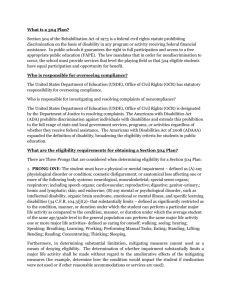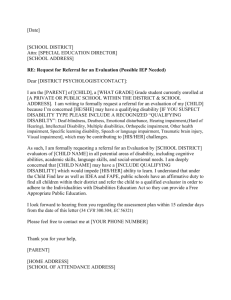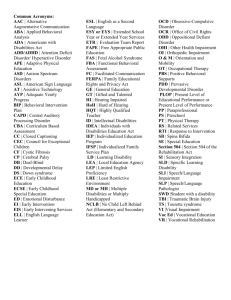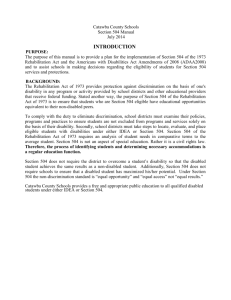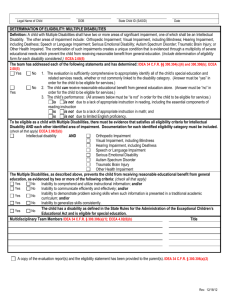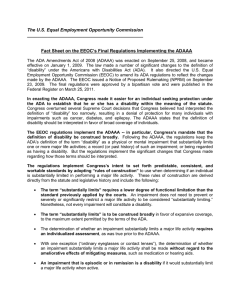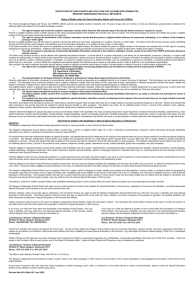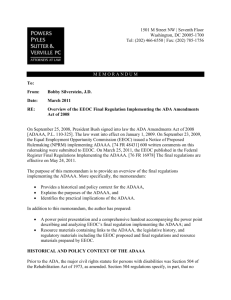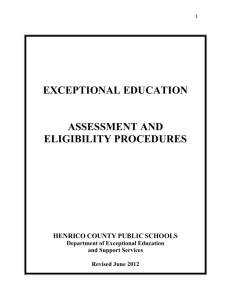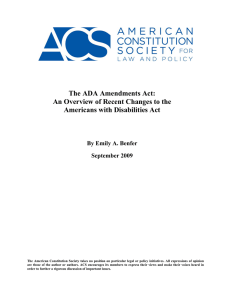Presentation - Keansburg School District / Home
advertisement
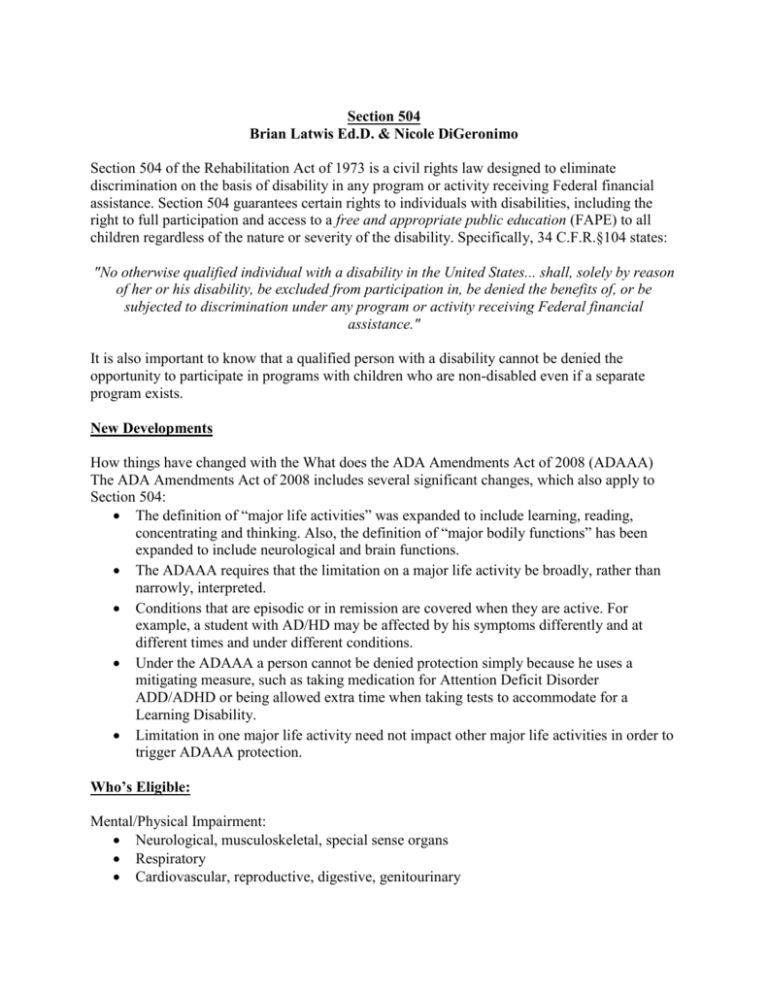
Section 504 Brian Latwis Ed.D. & Nicole DiGeronimo Section 504 of the Rehabilitation Act of 1973 is a civil rights law designed to eliminate discrimination on the basis of disability in any program or activity receiving Federal financial assistance. Section 504 guarantees certain rights to individuals with disabilities, including the right to full participation and access to a free and appropriate public education (FAPE) to all children regardless of the nature or severity of the disability. Specifically, 34 C.F.R.§104 states: "No otherwise qualified individual with a disability in the United States... shall, solely by reason of her or his disability, be excluded from participation in, be denied the benefits of, or be subjected to discrimination under any program or activity receiving Federal financial assistance." It is also important to know that a qualified person with a disability cannot be denied the opportunity to participate in programs with children who are non-disabled even if a separate program exists. New Developments How things have changed with the What does the ADA Amendments Act of 2008 (ADAAA) The ADA Amendments Act of 2008 includes several significant changes, which also apply to Section 504: The definition of “major life activities” was expanded to include learning, reading, concentrating and thinking. Also, the definition of “major bodily functions” has been expanded to include neurological and brain functions. The ADAAA requires that the limitation on a major life activity be broadly, rather than narrowly, interpreted. Conditions that are episodic or in remission are covered when they are active. For example, a student with AD/HD may be affected by his symptoms differently and at different times and under different conditions. Under the ADAAA a person cannot be denied protection simply because he uses a mitigating measure, such as taking medication for Attention Deficit Disorder ADD/ADHD or being allowed extra time when taking tests to accommodate for a Learning Disability. Limitation in one major life activity need not impact other major life activities in order to trigger ADAAA protection. Who’s Eligible: Mental/Physical Impairment: Neurological, musculoskeletal, special sense organs Respiratory Cardiovascular, reproductive, digestive, genitourinary Hemic and lymphatic Skin and endocrine Any mental or psychological disorder such as mental retardation, organic brain syndrome, emotional or mental illness, and specific learning disabilities *** Notice the definition does not include an extensive list of diseases…this is because it is not meant to limit what may be considered for a 504. Major life activities: 55 of them under new guidelines…they include but are not limited to: functions such as caring for one's self, performing manual tasks, walking, seeing, hearing, speaking, breathing, learning and working. When does an impairment “substantially limit a student’s major life activity”? Section 504 regulations do not define the word “substantially.” The Office of Civil Rights (OCR) directs school districts to make the decision of whether a particular impairment “substantially limits” a major life activity for a student on an individual basis. A physical or mental impairment does not constitute a disability for purposes of Section 504 unless its severity or educational impact is such that it results in a substantial limitation of one or more major life activities. Disabilities that are recognized under Section 504, include but are not limited to, if limitation in one or more major life functions exist: A Few Examples Attention Deficit Disorder (ADD-ADHD) Speech/Hearing / Visual impairments Orthopedic impairments Cerebral palsy Epilepsy Cancer Diabetes Mental retardation Emotional illness Specific learning disabilities Alcohol and drug addictions (applies to individuals not currently engaging in the use of illegal drugs – abusing alcohol) Rheumatoid arthritis Asthma Consistent academic failure (may at least prompt an evaluation under 504) How does a student become eligible to receive services and protection under Section 504? To become eligible for services and protection under Section 504, a student must be determined, as a result of an evaluation, to have a physical or mental impairment that substantially limits one or more major life activities. EVALUATION When should the district evaluate a student for a disability under Section 504? Occasions suggested by the Council of Administrators for Special Education include but are not limited to: · When a student is referred to the child study team for a special education evaluation, but is determined not eligible for services under the Individuals Disabilities Education Act (IDEA). · When a student is referred to the child study team and it is determined that a special education evaluation is not warranted. · When a student shows a pattern of not benefiting from the instruction provided. · When a student returns to school after a serious illness or injury. · When the student exhibits a chronic health condition. Section 504 requires that “information from a variety of sources be considered and documented prior to placement (aptitude and achievement tests, teacher recommendations, physical condition, social or cultural background, adaptive behavior, and observations from parents, teachers, and school personnel). ELIGIBILITY DETERMINATION What qualifies a student for programs and services under Section 504? Eligibility for programs and/or services under Section 504 is based on an affirmative response with documentation to the following qualifying questions: · Does the student have a physical or mental impairment? · Does the impairment affect one or more of the major life activities? · Does the impairment substantially limit a major life activity? Points to remember: Is attention deficit disorder (ADD) and attention deficit hyperactivity disorder (ADHD) a recognized disability under Section 504? Yes. The Department of Education has acknowledged that ADD and ADHD are impairments that can be the basis of eligibility under either Section 504 or IDEA. The key to eligibility under 504 is whether the student’s ADD or ADHD is sufficiently severe that it substantially limits a major life activity, e.g. learning. Does a physician’s diagnosis of ADD/ADHD automatically result in a student being eligible for Section 504? No. A physician’s diagnosis alone does not automatically result in eligibility for programs or services under Section 504. A physician’s diagnosis should be considered as one piece of the evidence when evaluating the child. Is a student with a physical or mental impairment who was referred to the child study team, but found ineligible for special education under IDEA, automatically covered under Section 504? No, depending on the severity of his/her condition, a student with an impairment who does not meet the standards for eligibility under the IDEA may or may not fit within the Section 504 definition. Can a parent elect to have a student with a disability who is eligible under the IDEA identified as covered under Section 504 only? No. Although a parent may wish to avoid having his/her child “labeled” as a special education recipient, the Office of Civil Rights (OCR) has stated in no uncertain terms that parents have no such flexibility. A rejection of the services offered under IDEA amounts to a rejection of services offered under Section 504. Conversely, it should be noted that a district has no flexibility to opt to provide services and accommodations under Section 504 when the student is IDEA eligible.


